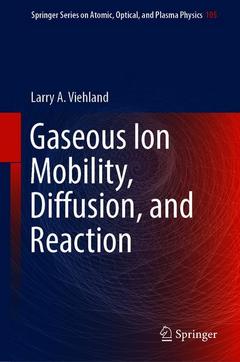Gaseous Ion Mobility, Diffusion, and Reaction, 1st ed. 2018 Springer Series on Atomic, Optical, and Plasma Physics Series, Vol. 105

Tentative Table of Contents. 1/1/18
Preface
Ch. 1: Introduction
1. Definition and Importance of Swarms
2. Air and Vacuum Pumps
3. Static Electricity
4. Current Electricity
5. Faraday’s Laws of Electricity
6. Electrical Conduction
7. Ions
8. Ion Swarms, 1896-1928
9. Ion Diffusion, 1855-1926
10. Electron Swarms, 1900-1922
11. Early Kinetic Theory, 1905-1931
12. Mass Spectrometers
13. Ion Swarms, 1928-1960
14. Electron Swarms, 1922-1965
15. Electron and Ion Swarms, 1960-1975
16. Atomic Ion-Atom Kinetic Theory
17. Ion-Neutral Reactions
18. Improved Kinetic Theories
19. Generalized Einstein Relations
20. Transport with Molecular Systems
Ch. 2: Experiments and Elementary Theory
1. General Assumptions
2. Basics of Drift Tubes
3. Drift-Tube Mass Spectrometers
4. Plasma Chromatographs/Ion Mobility Spectrometers
5. Qualitative Momentum-Transfer Theories
Ch. 3: Momentum-Transfer Theory
1. Essentials of Momentum-Transfer Theory
2. Relative Speed
3. Cross Sections
(a) Momentum Transfer in a Collision
(b) Average Momentum Transfer
4. Average Ion Momentum Lost in a Collision
(a) Average Drift Speed between Collision
(b) Classification of Collisions
(c) Archetype Collisions
5. Fundamental Ion Mobility Equation
6. Discussion
Ch. 4: The Boltzmann Equation
1. General Form
2. The Non-Reactive Collision Term
3. Reactive Collision Terms
4. Properties of an Ion Ensemble
5. Quantum-Mechanical Effects
6. The Maxwell Model
7. Rate Equation of Continuity
Ch. 5: Moment Method for Solving the Boltzmann Equation
1. Introduction
2. Cautionary Notes about Moment Methods
3. General Moment Equations
4. Successive Approximations
5. Solutions by the Method of Weighted Residuals
6. Basis Functions in General
7. One-Temperature Basis Functions
8. Two-Temperature Basis Functions
9. Matrix Elements in the Two-Temperature Method
10. Successive Approximations to the Mobility, Diffusion and Reaction-Rate Coefficients
11. Three-Temperature Basis Functions
12. Three-Temperature Numerical Results
Ch. 6: Gram-Charlier Approach to Ion-Molecule Reactions
Ch. 7: Connections with Atomic Ion-Atom Interaction Potentials
1. Ab Initio Ion-Neutral Interaction Potentials
2. Transport Cross Sections and Computer Program PC
3. Kinetic Theory using Gram-Charlier Approach and Computer Program GC
4. Zero-Field Mobilities
5. Field-Dependent Mobilities
6. Status of Tests of Interaction Potentials
Ch. 8: Molecular Ion and Neutrals
1. Visualization of Atomic Ion Velocity Distribution Functions
2. Implications for Ion-Molecule Reactions in the Upper Atmosphere
3. Extensions of the Boltzmann Equation
4. Ab Initio Calculations for Atomic Ions in Diatomic Neutrals
5. Ab Initio Calculations for Diatomic Ions in Atomic Neutrals
6. A Simple Way Forward: The Monchick-Mason Approximation
7. Beyond the Monchick-Mason Approximation
Ch. 9: Summary and Prognosis
Appendix A: Mathematics
Index
Represents an updated survey of the field, including modern theories and techniques
Introduces high-level mathematics gradually, through a historical survey of the field
Describes both precise and approximation techniques and the contexts in which one may be more practical than the other
Surveys types of apparatus used in this research area
Date de parution : 02-2019
Ouvrage de 301 p.
15.5x23.5 cm


